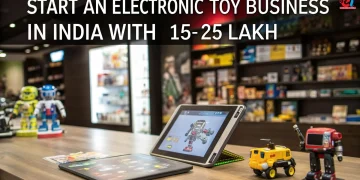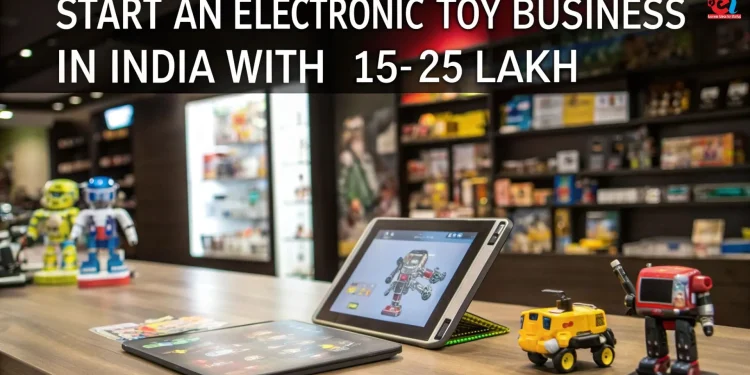The global toy industry is experiencing a remarkable change with the introduction of innovation, interactivity, and modern technologies into play. At the heart of this change is the burgeoning category of electronic toys which comprises remote-controlled cars, educational robots, interactive dolls, and sound and light toys. As parents look for smarter entertainment options that aid skill development and children increasingly prefer tech-driven toys, the demand for electronic toys is growing steadily both in India and abroad.
Amateur entrepreneurs and small-scale producers have an interesting chance to strive for. Electronic toys are no longer the monopoly of multinational corporations. Founded on a basic premise or built from the ground up to become a dependable OEM supplier with access to components, assembly units, and government schemes, building a toy brand is now plausible. Starting a brand comes with challenges that come with a well-defined strategy in design, sourcing, electronics, integration, safety compliance, branding, and finance.
In this article, I’ll guide you step by step on starting a business in the electronics toy industry, from choosing the right parts to planning the assembly lines and understanding cost models to estimating ROI.
The Scope of Study Relating to Electronic Toys
Some toys fall under the category of electronic toys including educational kits, musical toys, toys in motion, talking dolls, smart games, light-based toys, sensor-based toys, and STEM learning kits. These toys generally combine mechanical parts, electronic circuitry, sensors, microcontrollers, batteries, and appealing colorful shells made of child safe materials.
The electronic toys market is estimated to grow over 70 billion dollars by 2030 globally because of increasing number of nuclear families, increasing per capita income, and the growing demand for smart toys and educational toys. In India, the government’s Make in India and Atmnirbhar Bharat programs have much stimulated local industries to manufacture toys and reduce dependence on Chinese imports. Toy clusters will be introduced along with incentives under the Production Linked Incentive PLI scheme and BIS safety standards. This puts India in a good position to become a world leader in the production of electronic toys.
In addition to these factors, consumer behavior is changing too rapidly. Parents are more concerned with the cognitive skills of their kids. This has driven the demand for toys that help in learning instead of just entertaining. Toys meant for teaching coding, motor skills, and sensory development are more popular.
Selection of Components and Product Planning
It all starts with the idea and key components of an electronic toy. The first step in the manufacturing process is to determine the type of toys you intend to produce. These could range from motion based toys, sound and light toys, educational STEM toys, or character based toys that feature sensory voice output.
Once the product concept is developed, the next step is to find and procure the required components. An electronic toy is likely to consist internally of these parts:
- A microcontroller or logic board for governing toy behaviour
- Infrared, light, sound, proximity, and pressure sensors for interaction
- Motors and actuators for vibration and motion
- Small Speakers and LEDs for sound and visual feedback
- Buzzers for sound and visual feedback
- User control via push buttons, touch pads, and joysticks
- Power control circuit and Battery compartment
- Printed Circuit Boards (PCBs) to interconnect all parts electronically
Other than electronics, wheels, axle, joints, gears, and plastic molds should be of mechanical parts needed for structure and functionality. Safety compliance materials like non toxic plastics, lead free solder, and reinforced packaging also need to be part of the compliance of sourcing materials.
You can find local suppliers for electronic components or reach out to international ones. In India, component markets can be located in Delhi (Lajpat Rai Market), Mumbai, Bengaluru, and Pune. Shenzhen, China, continues to be a global sourcing hub, although there is a drawback of having import taxes and delays.
Related: Manufacturing of Plastic Toys
Designing the Assembly Line and Workflow
After sourcing, the next step on the list is to manufacturing and assembly. For larger scale businesses, an in-house unit can be set up, however, smaller businesses might require outsourcing partial assembly to contract manufacturers. Startups would benefit from a scalable assembly line.
Assembly outline usually includes the following steps:
- Population of PCB involves soldering electronic components into designated places within the printed circuit board.
- Sub-assembly: Integration of sensors, batteries, wires, switches, and powering them on.
- Block assembly: Electronics housed in plastic or flexible rubber molds.
- Written and cosmetic corrections: Branded and marked.
- Assemble boxes and coat with shrink wrap. Instructions manuals are to be included.
- Branded determine the name of the toy on package. The toy undergoes electronic leakage monitoring, fire hazard simulation, shock monitoring, and tiny loose bits disassociation checks. Most often through mandated provisions from B2B clients, export markets require BIS compliance, CE certification, or ASTM standards meeting.
The use of ergonomic workbenches, anti-static flooring and assembly tools such as soldering stations, hot-air guns, and multimeters increases productivity as well as quality. There is a significant reduction in expensive labor costs if you employ a small team of semi-skilled workers trained in basic electronics.
Safety Certifications and Compliances
Under the Toys (Quality Control) Order, no electronic toy can legally be sold in India without complying with BIS certification. Likewise, toys meant for export to the U.S. and Europe are required to meet the ASTM F963 and EN 71 standards, respectively. All certifications ensure that the toys do not pose electric shock hazards, choking hazards, and hazardous materials that are not safe for children.
The business also needs to be registered under the appropriate manufacturing license (such as UDYAM or SSI), and adherence to environmental guidelines concerning e-waste as well as plastic packaging is mandatory. Additional labels or testing may be necessary for compliance to DGCA air shipping regulations for toys with batteries.
By taking compliance seriously, businesses can safeguard their brand legally while also building trust with distributors, retailers, and end consumers. During development, alliances with BIS-accredited labs and third-party quality auditors will help in reducing the certification delays and product rejection.
Marketing and Distribution Strategies
The worst part starts after you get a prototype to market. You may either sell your toys under your own label or manufacture under private label agreements. For example, Amazon and Flipkart eCommerce websites, FirstCry, and Meesho offer quick and easy access to the consumer market. Offline channels include retail toy stores, school supply chains, learning centers, and stall shops during festivals.
In the electronic toys sector, working toward a brand requires smart packaging, appealing graphics, child-friendly interface, and advertising for parents. Mentioning Educational value, battery life, reusability, and safety guarantee should be given focus. Selling products online requires contact with influencers, festive promotion which includes Diwali, Christmas, Children’s Day, and promotional videos for better visibility.
Trade fairs serve as direct access points for buyers, allowing exporters to participate in the Hong Kong Toy Fair, Spielwarenmesse (Germany), and Toy Biz International (India). They can also register on B2B sites like Alibaba, IndiaMART, and TradeIndia further opens the door to wholesale orders from schools, retail chains, and institutional clients.
Related: How to Start Kids Electronic Toys Factory
Conclusion: Electronic Toys as a Gateway to India’s Smart Manufacturing Future
The market for electronic toys is more than a trend—it’s a reflection of how the world is rethinking childhood learning, leisure, and development. As technology becomes embedded in daily life, toys that help children interact, explore, and problem-solve through play are in high demand. For manufacturers, this opens up an exceptional opportunity to combine creativity with commerce.
India, with its manufacturing capabilities, policy support, and growing talent pool, is primed to become a global center for electronic toy production. Entrepreneurs who understand the pulse of the market, invest in quality and safety, and build a strong value proposition are poised to ride this wave of innovation and demand.
Whether you are an engineer, designer, educator, or investor, stepping into the world of electronic toys is not just profitable—it’s a chance to shape the future of play.


























